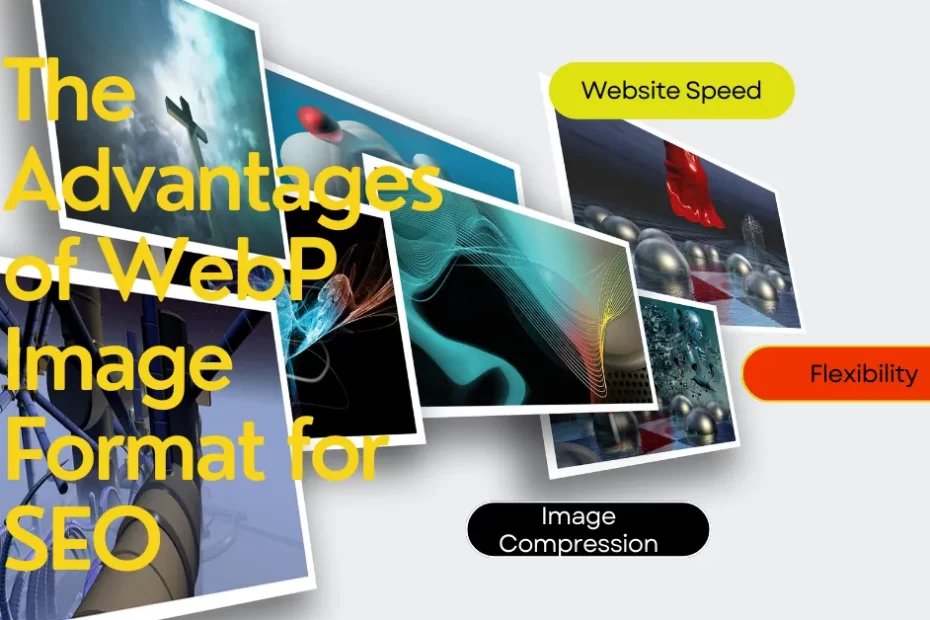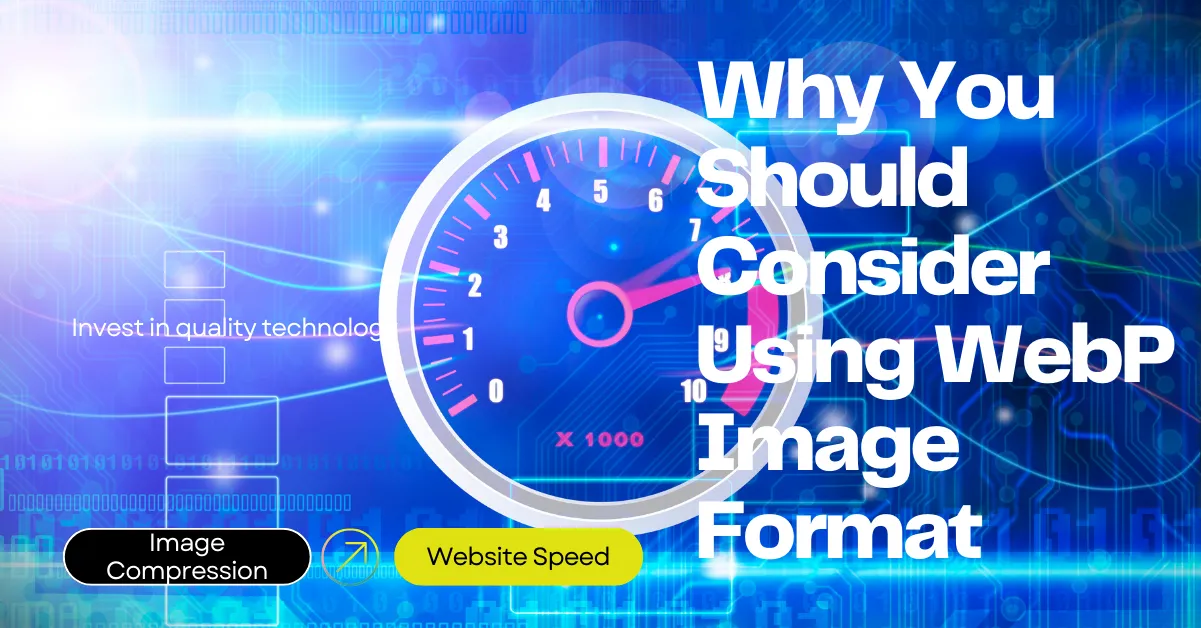WebP is a modern image format developed by Google that offers superior compression and smaller file sizes than traditional image formats such as JPEG and PNG. This makes it an excellent choice for website owners who want to improve website speed and reduce bandwidth usage.
Here are some reasons to consider using WebP for your website’s images.
The Advantages of WebP Image Format for SEO
WebP image format benefits website speed and bandwidth usage and can improve your website’s search engine optimization (SEO). Here are some advantages of using WebP image format for SEO.
Better Image Optimization
- Higher quality images
- Smaller file sizes
- Faster load times
Higher Quality Images – Enhanced Visual Quality
WebP also provides enhanced visual quality compared to image formats such as JPEG and PNG. Lossy compression ensures that all unnecessary data is removed from images while providing superior visual fidelity and better sharpness than standard image formats.
WebP images provide higher quality images at smaller file sizes than traditional image formats, making them ideal for high-resolution images that need to maintain image quality.
Smaller File Sizes – Lesser Storage Space Usage
Unlike other image formats, WebP works on lossy and lossless techniques, so it uses less storage space by compressing your images without sacrificing their quality or detail. This reduces the overall weight of the files being served—especially beneficial when transferring pictures over the Internet or hosting them on a server with limited capabilities.
Smaller file sizes result in faster load times and reduced bandwidth usage, improving website speed and user experience. The images are up to 34% smaller than equivalent JPEG images and up to 50% smaller than equivalent PNG images, resulting in reduced bandwidth usage and lower hosting costs.
Faster Load Times – Improve Website Loading Times
One of the most significant advantages of using WebP as an image optimization tool is that it dramatically reduces website loading times. It supports lossless formats, which compress your images at a higher rate than traditional image optimization tools and even further reduce file size without sacrificing any quality, ultimately leading to faster loading speeds for your web pages.
Faster load times can lead to improved user engagement and a lower bounce rate, which are crucial for SEO. WebP images load faster than traditional image formats, resulting in a better user experience and improved website speed.
Improved Page Speed
- Faster load times
- Better user experience
- Improved search engine rankings
Advanced Transparency Features
Regarding transparency, WebP offers advanced features such as alpha channel support for 24-bit RGB + 8-bit Alpha channel, which makes gradients look smoother and allows you to achieve a better final product with less effort.
You can also set the level of blending between two color channels, which adds another dimension to your designs by increasing the realism of photos and graphics.
Better User Experience
Improved page speed leads to better user experience, reducing bounce rates and increasing user engagement.
Improved Search Engine Rankings
Website speed is an essential factor in search engine rankings, and using WebP images can help to improve your website’s ranking on search engine results pages.
Improved Browser Compatibility – Wide Browser Support
Major web browsers, including Chrome, Firefox, Edge, and Opera, support WebP. This ensures that a large audience can view your optimized WebP images without compatibility issues.
Most modern browsers are now compatible with WebP due to Google’s widened scope beyond highly technical programs like Chrome. WebP is now more broadly included within multiple browsers, such as Android’s native browser and Safari or Microsoft Edge’s equivalents. This makes this transition more seamless for users regardless of their platform.
More Flexibility in Optimizing for Different Devices
WebP format offers enhanced flexibility for optimizing images across various devices. With its capability to support non-transparent and transparent versions, WebP allows you to tailor images to different display needs, from desktop browsers to mobile devices.
This means you can fine-tune your visuals without sacrificing quality, ensuring that pictures rendered on smaller devices maintain clarity and color accuracy, unlike traditional formats such as JPEG or PNG.
Moreover, WebP’s efficiency is reflected in its reduced file sizes, which can help minimize resource usage while maximizing visual presentation. This allows for smooth loading times and a better user experience, regardless of the viewer’s device.
Free & Easy Image Formats Conversion Options
If you need to convert your existing JPG or PNG files to WebP, many free online tools are available for batch processing, making it easy to streamline your workflow. You can efficiently condense large volumes of content into optimized images while collaborating across different platforms and devices.
This capability ensures that your projects won’t be hindered by heavy file sizes or format restrictions, allowing quicker adjustments and edits without the burden of cumbersome management.
How to Convert Your Images to Webp Format in 3 Simple Steps
JPG/PNG to WebP Format & Resizer
Step 1: Convert PNG or JPG to WebP
Step 2: Select size to Resize - Press Original Size to change
Step 3: Press Converted file to download
The JPG/PNG to WebP and Size Resizer is a web-based application that allows users to convert their images from JPG or PNG to WebP format. This modern image format provides superior lossless and lossy compression for pictures on the web.
The application is straightforward to use. Users can upload multiple images by clicking on the file input field. The application supports only JPG and PNG formats for conversion.
In addition to the conversion feature, the application resizes the image. Users can select from predefined resize options 30%, 50%, and 80% of the original size or keep the original size. The resizing happens before the conversion to WebP format.
Once the images are uploaded and the desired resize option is selected, users can start the conversion process by clicking the “Convert” button. The application will convert and resize each image individually.
After the conversion, the application provides download links for each converted image. The links are displayed in the application’s output section. Users can click on each link to download the corresponding WebP image.
This application is a handy tool for web developers and designers. It helps optimize images for the web, reducing load time and improving page performance.
Boost Website Speed: Beyond WebP – Key Factors for Faster Loading
Besides using the WebP image format, several other factors can contribute to making a fast website. Here are some additional techniques and optimizations:
Caching: Implement browser caching to store static files, such as images, CSS, and JavaScript, on the user’s device. This makes subsequent page loads faster since the cached files are retrieved locally instead of downloading them again.
Minification: Minify your HTML, CSS, and JavaScript files by removing unnecessary spaces, line breaks, and comments. This reduces file sizes and improves loading speed.
Content Delivery Network (CDN): Utilize a CDN to distribute your website’s content across multiple servers in different geographic regions. This helps deliver content to users from the nearest server, reducing latency and improving loading times.
Compression: Enable compression on your server to reduce the size of files transferred from the server to the user’s browser. Gzip and Brotli are commonly used compression methods.
Optimized CSS and JavaScript: Optimize your CSS and JavaScript code by removing unused code, reducing the number of HTTP requests, and placing scripts at the bottom of the page to prevent render blocking.
Lazy Loading: Implement lazy loading for images and videos, where they are loaded only when they become visible within the viewport. This approach improves initial page load times by deferring the loading of non-visible content.
Responsive Design: Ensure your website is responsive and mobile-friendly. Responsive design ensures that the layout and content adapt to different screen sizes, optimizing the user experience on various devices.
Minimize Redirects: Avoid unnecessary redirects as they add additional HTTP requests and increase page load times. Redirects should be used sparingly and only when necessary.
Optimized Hosting: Choose a reliable and fast hosting provider with good server response times. Consider using a hosting solution optimized for your specific needs, such as a managed WordPress hosting service.
By implementing these techniques, you can significantly improve your website’s loading speed and provide a faster browsing experience for your users. Remember that website optimization is an ongoing process; regularly monitoring and fine-tuning your site’s performance is essential to maintain its speed.




